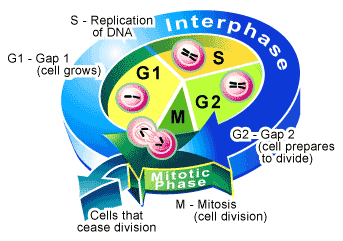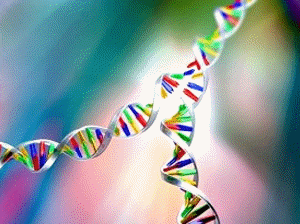 Phases of cell cycle The cell cycle/cell division, is the series of events taking place in a cell leading to its division and duplication of genetic material. In cells with a nucleus i.e., in eukaryotes, the cell cycle can be divided in two periods:
Phases of cell cycle The cell cycle/cell division, is the series of events taking place in a cell leading to its division and duplication of genetic material. In cells with a nucleus i.e., in eukaryotes, the cell cycle can be divided in two periods:
- interphase : It is the resting phase in which the cell grows, accumulating nutrients needed for mitosis and duplicating its DNA- the genetic material.
- The mitotic (M) phase, during which the cell splits itself into two distinct cells, called as daughter cells and
- The final phase, cytokinesis, where the cytoplasm divided in to two new daughter cells.
Every cell that is capable of undergoing division passes through a cyclic sequence of events involving growth and division.
It is called Cell Cycle. It encompasses the entire sequence of events that occur in a cell from the time it is formed from its parent cell till the time of its own division into daughter cells.
Many critical events occur during the cell cycle in the life of a cell. Mitosis is just one part of the cell cycle. In fact, the mitotic (M) phase, which includes both mitosis and cytokinesis, is usually the shortest part of the cell cycle. Mitotic cell division alternates with a much longer stage called interphase, which often accounts for about 90% of the cycle. It is during interphase that the cell grows and copies its chromosomes in preparation for cell division. Interphase can be divided into : G1 phase/first gap cycle, S phase/ synthesis cycle, G2 phase/ second gap cycle. Overlapping with the latter stages of mitosis, cytokinesis completes the mitotic phase.
| Phase | Events within cell |
|---|---|
| G1 | Intensive cellular synthesis, mitochondria, chloroplasts (in plants), ER, lysosomes, Golgi complex, vacuoles and vesicles produced. Nucleus produces rRNA, mRNA and tRNA and ribosomes are synthesized. Cell produces structural and functional proteins. Cell metabolic rate is high and controlled by enzymes. Cell growth occurs. Substances produced to inhibit or stimulate onset of next phase. |
| S | DNA replication occurs. Protein molecules called histones are synthesized and cover each DNA strand, Each chromosome will become into two chromatids. |
| G2 | Intensive cellular synthesis. Mitochondria and chloroplasts divide. Energy storage increases. Mitotic spindle begins to form. |
| Mitosis | Nuclear division occurs in four phases |
| C | Equal distribution of organelles and cytoplasm into each daughter cells |
 DNA replication
DNA replication Thus, a cell grows (G1), continues to grow as it copies its chromosomes (S), grows more as it completes preparations for cell division (G2), and divides (M). The daughter cells may then repeat the cycle. A typical human cell might undergo one division in 24 hours. Of this time, the M phase would occupy less than 1 hour, while the S phase might occupy about 10 to 13 hours or about half the cycle. The rest of the time would be apportioned between the G1 and G2 phases. The G2 phase usually takes 4 to 6 hours; in our example, G1 would occupy about 5 to 6 hours. G1 is the most variable in length in different types of cells.